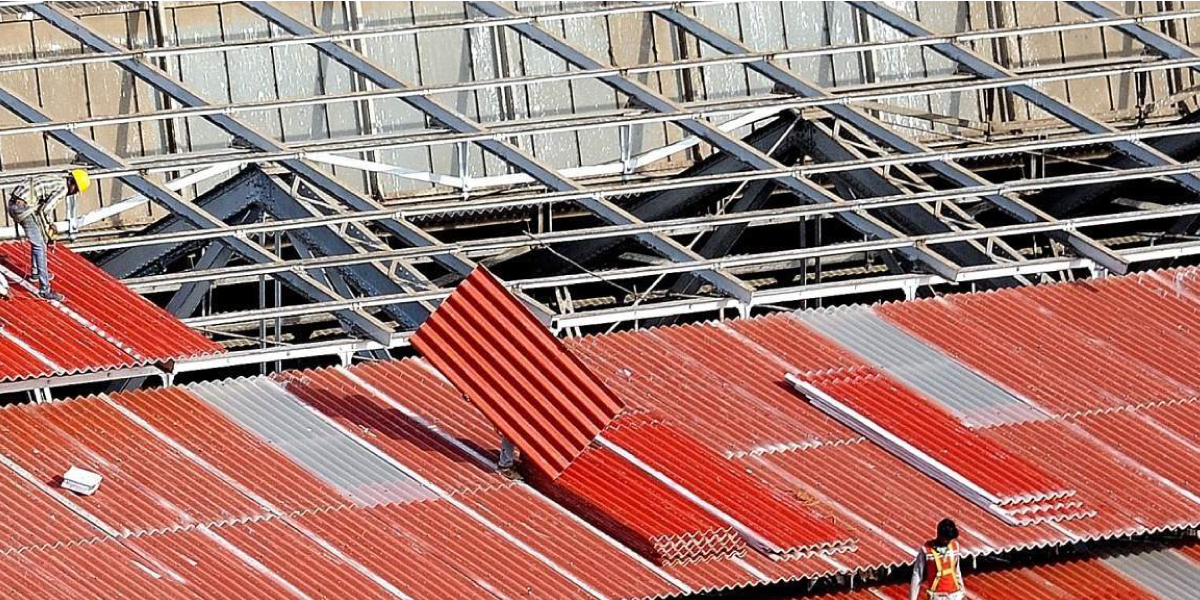A new house must be equally strong as beautiful. Building a new home is pretty exciting but is much more than just construction work. It includes the appropriate knowledge about the important elements of each part of the house. As we discussed the tools and installation required for drywalls in our previous article, we will move further to the different components for roofing, windows, doors, tiles, and countertops. You can build houses in various sizes, shapes, designs, etc. Understanding such crucial components can ease your job of planning well about your new home before the construction starts.
Although being a contractor of your own house is possible, it's best to hire a professional contractor with the required expertise. Only a professional contractor company understands the intricate details of building and designing a house without any flaws. In addition, they can help you with the best possible materials, designs, and tools.
Meanwhile, here is some basic knowledge about the crucial components of constructing a new home. Let us dig in further to the step-by-step guide in two essential parts - Construction and Architecture.
Construction
Preparation of construction site
Before the builder starts working on the site, you need to get the necessary work permits from the local governing body. They will approve the house design and other pre-requisites through a permit like zoning, grading, septic system construction, linking with drainage, etc. This is an essential factor as constructing a home can bring various changes to the surrounding land.
After you acquire the permits, it’s time to get the construction ready. Generally, the contractor will advise the builders to clear the construction site by removing unnecessary trees, debris, rocks, etc. This is followed by levelling the ground.
At this point, a surveyor can help by looking at the house’s blueprint and boundaries. They can suggest any alterations if needed for water flow across the site. Also, hiring an electrician can help mount a temporary source of electricity at the site of construction.
The builders can begin with the house’s foundation, which includes digging holes and trenches to put up necessary structures like pillars of the house, basement, etc. In cases where the house will have a well, it is dug at this point. Builders will halt any activity once the holes and trenches are filled with concrete until the concrete gets solid.
Since the construction work is quite hectic and time-consuming, do not forget to provide the builders with necessities like drinking water and toilet facilities.
Install HVAC and plumbing fixtures
If you are proceeding with a slab-type foundation, the plumbers and electricians must install the crucial plumbing fixtures before pouring the concrete. In this step, electricians and plumbers will install the following important elements:
Wiring
Pipes and sewer lines
Vents and ductwork for HVAC systems
Water Supply Lines
Shower and bath units
Walls and roofing
Once the foundation electrical fixtures are laid, you can construct the sides and ceilings. Electricians can install the wiring and other plumbing fixtures in the walls and ceilings simultaneously. After the roofing gets completed, the house is said to be “dried in.” The electricians will install the power outlets, light fixtures, switchboards, etc. linking them to the primary electric source. This also includes wiring for cable TV, telephones, and home theatres systems.
Apart from being aesthetic, the walls and roof of your home need to be strong and sturdy. As they form the basic structure, you need to keep the following tips for the best quality walls and roofing.
- The Bricks and blocks must be laid on a full bed of mortar.
- All the joints and crevices must be filled with mortar.
- The brickwork must be uniform and well packed for stability.
Furthermore, proper plastering is necessary for a smooth interior and exterior surface, as we discussed in our previous article about installing drywall aluminium.
Install insulation and waterproofing
Once the house is built, you need to work on the safety elements- insulation and waterproofing.
Insulation: A proper insulation is a key to an energy-efficient home. Yes, insulation helps maintain a consistent indoor temperature that facilitates the optimal functioning of HVAC units like air conditioners and heaters.
Insulation is done based on the R-value, which determines the heat transfer rate of the material used. Although it depends on the region and climate, fibreglass, mineral wool, concrete blocks, cellulose, and foam are the most commonly used insulation materials.
Waterproofing: Just as insulation is required to maintain the house’s temperature, waterproofing is needed to protect it from moisture. If you omit this step, it can cost you a lot of money on unprotect seepage of water into the walls and roof. To make matters worse, the persistence of water can also lead to corrosion of the metal framework, putting the whole structure at risk.
Most professional contractor companies recommend waterproofing on basements, terraces, and water-prone areas like the kitchens and bathrooms.
Finishing texture and painting
After extensive installation, insulation, and waterproofing, drywalls and roofing must be given a final finishing. It is also known as the priming of walls. You can also go for a custom texture of walls and choose the desired paint at this step.
Painting and giving your walls and ceilings a texture can also be done by the homeowners saving money. However, large houses demand extensive work which can be done by professional painters only.
Starting with the interior fixtures
As your painter has given the desired paint and texture to the house, it's time to move on to the important interior fixtures. This includes windows, doors, countertops, tiles, etc. You can choose doors and windows based on different sizes, shapes, and materials. Also, you can choose from different styles like double doors, sliding doors, grilled windows, glass panes, etc.
For other interior fixtures like countertops, Most professional contractors recommend hiring countertop specialists. Countertop specialists design as well as install the countertops. After this, you can contact bathroom and kitchenware speciality companies that provide kitchen and bathroom fixtures. These include cabinets and other fixtures such as showers, toilet seats, sinks, faucets, etc.
Flooring
Finally, your house needs a hard floor surface for stability and proper landscaping. You can choose from various flooring options like hardwood flooring, marble, carpeting, ceramic tiles, luxury vinyl plank, etc. You can also use some of the materials like ceramic and marble in countertops.
Removal of dumpNo work is complete without cleaning the dump from the site. Not keeping the surroundings clean can cause serious damage. It will turn into a breeding ground for insects, bacteria, mould ageing and cause aluminium hazards. You can call a professional cleaning agency for quick and efficient cleaning for the beautiful finished look of your new home.
Architecture
Just as the right way of construction is required for a perfect new house, architecture also plays an important role. Nothing can be started and finished flawlessly without proper planning. While construction includes the building of the structure, architecture covers the areas of designing and providing a visual plan of the house.
Roofing
Roofing is a pre-interior aspect of a house as it covers the homes and protects them from rain, snowfall, and sunlight. That’s why it's necessary to choose the right and durable materials for the same.
Materials: Most typical materials for roofing include wood, metal, asphalt, slate, tiles, etc. Layering with HVAC ductwork, wiring, etc., can also determine the suitable material for the roof.
Re-roofing and replacement: If you are to change your roof covering, it's necessary to remove the old roof material and then install the new one. It's always better to start it from scratch by removing it till sheathing. It helps get rid of any kind of rotting or damage present in the layers.
Roof ventilation: Ventilation is an essential part of the roof as it promotes ambient air circulation. Improper ventilation can result in problems in the long run, such as excessive energy loss, ice dams, etc. Get it right and enjoy ambient temperatures and no energy loss in any given weather. Different types of ventilation include soffit vents, ridge vents, and gable vents.
Waterproofing: As mentioned above in the construction section, waterproofing is mainly done for external parts like the roof. As the name suggests, waterproofing protects the whole structure from moisture seeping inside the walls and ceiling.
The most water-prone region of the roof is often the valleys formed where two roof planes intersect or where the roof is connected to a vertical surface such as a vent, chimney, pipe, etc. Various waterproofing ways include installation underlayments, drip edges, etc.
Roof maintenance:of maintenance: Various premium materials like asphalt shingles come with warranties, but routine maintenance and repair are key to long-lasting roofing. You must address issues like storm damage, natural ageing, or faulty installation on time.
Interior fixtures
Other crucial components like windows, doors, countertops, tiles, etc., come under the interior fixtures and require the correct architecture. All of them have a massive impact on the overall look and feel of the house. But they need to be designed and installed correctly to achieve that impeccable look you want in your new home.
Doors and windows: Apart from the different styles like double windows, casements, and sliders, you also need to decide the material. This includes both the frame material and window glass material. The most common materials include vinyl, aluminium, fibreglass, composites, wood, etc. Nowadays, you also get to see energy-efficient, high-performance windows for modern homes.
Choosing the correct door type for your home requires considering factors like material, colour, hinges, etc. Or do you want to have a twisting handle or a doorknob? All these factors need to be discussed before finalising the door. The most profound materials of doors are hardwood like oak, unbreakable glass doors, etc.
Tiles: A uniform tile job looks appealing to the eyes. In addition, they elevate the house’s overall aesthetics when you get a variety of designs and textures to choose from. Gone are the days when you were limited to only 6X6 square tiles! Nowadays, you get to choose from several shapes, sizes, and designs to match your requirements. For example, porcelain tiles with decorative motifs give a luxurious touch to the wall.
Also, just like roofing, the tiling work needs routine maintenance. This might include cleaning grouts and stains and replacing the broken or damaged tiles.
Countertops: Countertops are an essential component of a home’s interior which contributes to overall aesthetics. Commonly known as kitchen countertops, they are available in various materials and designs to fit your requirements. They must be durable and resistant to stains and cracking.
A countertop specialist can help you with suitable material and installation. Although granite and marble remain the most sought countertop materials for their timeless beauty, modern architecture has also embraced stainless steel.
Why do you need to hire a professional contractor?
Building a home can be a daunting task. From the right design to the right construction of the house, a homeowner alone cannot handle all of the tasks together. While some knowledge can help you understand the process, it's best to hire a professional contractor. Apart from easing the stress, here are some advantages of hiring a professional contractor:
A good contractor always works with a team of experts for best construction practices.
As the contractor has a scheduled approach to the work, it saves you a lot of time.
You can clear any doubts any time from them.
Designing and building a home is exciting and challenging at the same time. After a brief look into the roofing and interior components, the next challenge lies ahead with bathroom architecture. As the bathroom is an important part of your home, the step-by-step guide helps you with the right types and ways of installing the bathroom fixtures.
If you are looking forward to building a new home or are a construction enthusiast, we provide you with the latest construction news and useful articles. With the proper knowledge and techniques, aluminium is an amazing opportunity to transform the world!


















